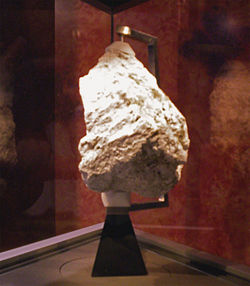Feldspar

Feldspar is the name of a group of rock-forming minerals which make up as much as 60% of the Earth's crust.
Feldspars crystallize from magma in both intrusive and extrusive rocks, and they can also occur as compact minerals, as veins, and are also present in many types of metamorphic rock. Rock formed entirely of plagioclase feldspar (see below) is known as anorthosite. Feldspars are also found in many types of sedimentary rock.
Etymology
Feldspar is derived from the German Feld, field, and Spat, a rock that does not contain ore. "Feldspathic" refers to materials that contain feldspar. The alternative spelling, felspar, has now largely fallen out of use.
Compositions
This group of minerals consists of framework or tectosilicates. Compositions of major elements in common feldspars can be expressed in terms of three endmembers:
Anorthite endmember CaAl2Si2O8
Solid solutions between K-feldspar and albite are called alkali feldspar. Solid solutions between albite and anorthite are called plagioclase. Only limited solid solution occurs between K-feldspar and anorthite, and in the two other solid solutions, immiscibility occurs at temperatures common in the crust of the earth.
Sanidine (monoclinic), orthoclase, and microcline (triclinic) refer to polymorphs of K-feldspar. Sanidine is stable at the highest temperatures, and microcline at the lowest. Perthite is a typical texture in alkali feldspar, due to exsolution of contrasting alkali feldspar compositions during cooling of an intermediate composition. The perthitic textures in the alkali feldspars of many granites are coarse enough to be visible to the naked eye.
Compositions of the plagioclase series have been labeled as follows (percent anorthite in parentheses):
- albite (0 to 10)
- oligoclase (10 to 30)
- andesine (30 to 50)
- labradorite (50 to 70)
- bytownite (70 to 90)
- anorthite (90 to 100)
Intermediate compositions of plagioclase feldspar also may exsolve to two feldspars of contrasting composition during cooling, but diffusion is much slower than in alkali feldspar, and the resulting two-feldspar intergrowths typically are too fine-grained to be visible with optical microscopes. The immiscibility gaps in the plagioclase solid solution are complex compared to the gap in the alkali feldspars. The play of colors visible in some feldspar of labradorite composition is due to very fine-grained exsolution lamellae (see image).
Uses
- Feldspar is a common raw material in the production of ceramics.
- Feldspars are used for thermoluminescence dating and optical dating in earth sciences and archaeology
- Feldspar is an ingredient in Bon Ami brand household cleaner.
See also
- List of minerals
Template:Mineral-stub
ca:Feldspat cs:Živec da:Feldspat de:Feldspat et:Päevakivi es:Feldespatos eo:Feldspato fa:فلدسپات fr:Feldspath ko:장석 is:Feldspat it:Feldspato he:פצלת השדה lv:Laukšpats lt:Lauko špatas hu:Földpátok nl:Veldspaat ja:長石 pl:Skaleń pt:Feldspato ro:Feldspat ru:Полевые шпаты sk:Skupina živca fi:Maasälpä sv:Fältspat tr:Feldspat zh:长石